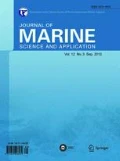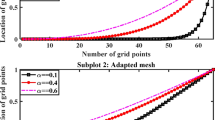Abstract
The localized differential quadrature (LDQ) method is a numerical technique with high accuracy for solving most kinds of nonlinear problems in engineering and can overcome the difficulties of other methods (such as difference method) to numerically evaluate the derivatives of the functions. Its high efficiency and accuracy attract many engineers to apply the method to solve most of the numerical problems in engineering. However, difficulties can still be found in some particular problems. In the following study, the LDQ was applied to solve the Sod shock tube problem. This problem is a very particular kind of problem, which challenges many common numerical methods. Three different examples were given for testing the robustness and accuracy of the LDQ. In the first example, in which common initial conditions and solving methods were given, the numerical oscillations could be found dramatically; in the second example, the initial conditions were adjusted appropriately and the numerical oscillations were less dramatic than that in the first example; in the third example, the momentum equation of the Sod shock tube problem was corrected by adding artificial viscosity, causing the numerical oscillations to nearly disappear in the process of calculation. The numerical results presented demonstrate the detailed difficulties encountered in the calculations, which need to be improved in future work. However, in summary, the localized differential quadrature is shown to be a trustworthy method for solving most of the nonlinear problems in engineering.
Similar content being viewed by others
References
Anderson JD Jr (2000). Hypersonic and high temperature gas dynamics. AIAA Inc., Virginia, 368–369.
Bellman RE, Kashef BG, Casti J (1972). Differential quadrature: a technique for the rapid solution of nonlinear partial differential equations. Journal of Computational Physics, 10(1), 40–52.
Busegnies Y, François J, Paulus G (2007). Unidimensional SPH simulations of reactive shock tubes in an astrophysical perspective. Shock Waves, 16(4–5), 359–389.
Civian F, Sliepcevich CM (1984). Differential quadrature for multidimensional problems. Journal of Mathematical Analysis and Applications, 101, 423–443.
Courant R, Friedrichs KO (1985). Supersonic flow and shock waves. Springer, 116–138.
Lam KY, Zhang J, Zong Zhi (2004). A numerical study of wave propagation in a poroelastic medium by use of localized differential quadrature method. Applied Mathematical Modelling, 28(5), 487–511.
Liepmann HW, Roshko A (2001). Elements of gas dynamics. Dover Publications, New York, 79–83.
Quan JR, Chang CT (1989). New insights in solving distributed system equations by the quadrature methods-I: analysis. Computational Chemical Engineering, 13, 779–788.
Shu C (2000). Differential quadrature and its applications in Engineering. Springer, Berlin, 340.
Sod GA (1978). A survey of several finite difference methods for systems of nonlinear hyperbolic conservation laws. Journal of Computational Physics, 27, 1–31.
Toro E (1999). Riemann solvers and numerical methods for fluid dynamics. Springer, 152–162.
Wu Xionghua (2007). Differential quadrature method based on the highest derivative and its applications. Journal of Computational and Applied Mathematics, 205, 239–250.
Zong Zhi, Lam KY (2002). A localized differential quadrature method and its application to the 2D wave equation. Computational Mechanics, 29, 382–391.
Zong Zhi, Zhang Yingyan (2009). Advanced differential quadrature methods. Chapman & Hall/CRC, 189–208.
Author information
Authors and Affiliations
Corresponding author
Additional information
Zhi Zong was born in 1964. He is a professor of Dalian University of Technology. His current research interests include: 1) computational mechanics and computational methods (FEM, BEM, differential quadrature, meshless method, SPH, VOF); 2) Linear and non-linear dynamics (solid mechanics, fluid mechanics, shock, impact, sound and vibration); 3) fluid-structure interactions in engineering and in the human body, etc.
Zhangrui Li was born in 1985. He is a phD candidate of the Department of Naval Architecture and Ocean Engineering at Dalian University of Technology. His current research field includes: numerical calculation, bubble dynamics of underwater explosion and the response of the ship subjected to the underwater explosion loading.
Jing Dong was born in 1986. She is a master student of the Department of Naval Architecture and Ocean Engineering at Dalian University of Technology. Her current research field is numerical simulation of the vortex induced vibration of the deep ocean riser using discrete vortex method.
Rights and permissions
About this article
Cite this article
Zong, Z., Li, Z. & Dong, J. Solving the sod shock tube problem using localized differential quadrature (LDQ) method. J. Marine. Sci. Appl. 10, 41–48 (2011). https://doi.org/10.1007/s11804-011-1040-y
Received:
Published:
Issue Date:
DOI: https://doi.org/10.1007/s11804-011-1040-y




